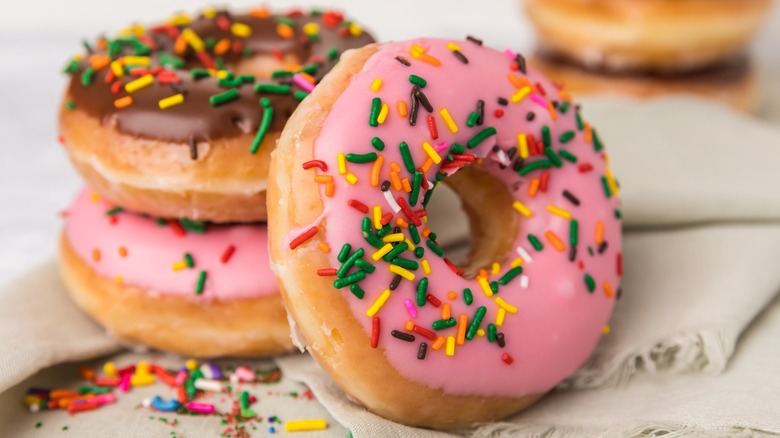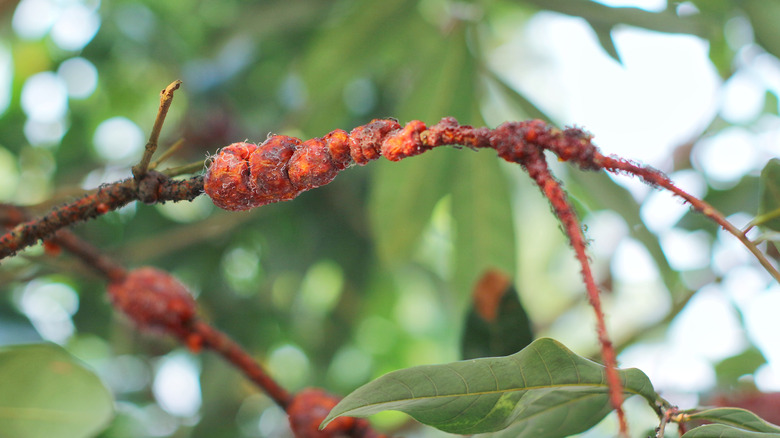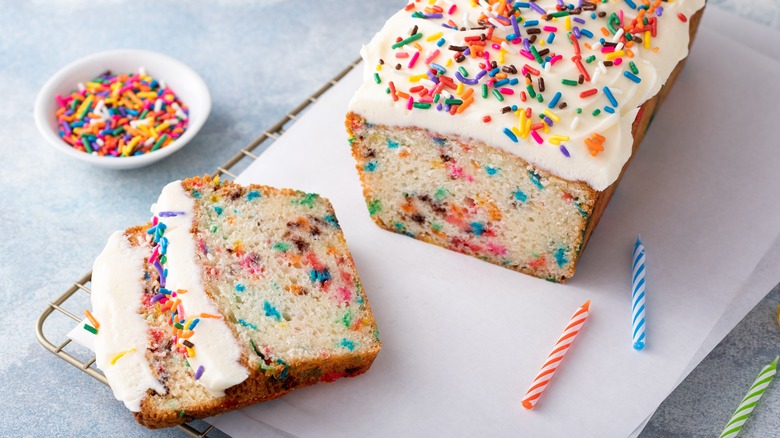The Ingredient That Makes Sprinkles A Risky Choice For Vegans
Sprinkles are the finishing touch of the dessert world. The tiny pieces of candy add an extra pop of sweetness, color, and texture to beloved treats. You'll find them on top of ice cream, birthday cake, cupcakes, cookies, and of course, donuts. Sprinkles come in rainbow, chocolate, and every color and flavor in between. When shaped like little orbs, they are known as nonpareils or hundreds-and-thousands — and when cylindrical, they're called Jimmies. There are dragées, which are small, edible metallic beads used to bejewel cakes, and there are also shaped sprinkles, often in holiday motifs.
Shellac is an ingredient many brands put in sprinkles, and it's not always listed on the label by name. More commonly referred to as confectioner's glaze, shellac is a coating that gives candies a shiny, firm outer layer. Vegans avoid foods with shellac, but even non-vegans may be shocked to learn the reason why — shellac is made from the secretions of the lac insect — and it's used in a lot more candies and foods than you might realize.
Harvested primarily in India and Thailand, lac insects (LacciferLacca) swarm tree branches and feed off sap, in turn excreting a resin that hardens into a cocoon, eventually encasing the lac nested inside. The buildup gets raked off the branches — bugs, eggs, and all — and processed either into shellac or lac dye, which gets its color from the insects' red bodies. Shellac has been likened to the insect equivalent of castoreum, the vanilla flavoring from beavers.
You're probably eating bugs without knowing it
You may be more familiar with shellac as an industrial product. Before vinyl, record albums were made from shellac, and it is used in furniture polish, varnish, and sealants, as well as cosmetics, nail polish, hair spray, and even tattoo ink. Pharmaceutical-grade shellac coats pills and vitamins to ease swallowing and allows for time-release drugs. Along with candy and sprinkles, food-safe shellac is used on coffee beans and fruits to preserve freshness and slow down ripening.
Eating sprinkles is risky for vegans because shellac goes by other names that disguise its source. Officially known as food additive E904, the ingredient is usually labeled as confectioner's glaze, confectioner's resin, resinous glaze, candy glaze, natural glaze, or pure food glaze. Despite the innocuous designations, these are all just other names for animal-derived shellac.
For those who wish to avoid shellac, there are alternatives. Zein is a corn-based, vegan coating that is biodegradable, renewable, and made in the USA. The Vegetarian Society of the United Kingdom references new shellac substitutes in development based on vegetable and citrus oils. The organization no longer allows new products with shellac to use its VegSoc logo, which identifies foods suitable for vegetarians and vegans. Companies that were previously granted use of the logo must reformulate their products without shellac, or cease using the logo by December 31, 2023.
Have your insect-free funfetti cake and eat it too
The only way to avoid consuming shellac is to diligently read ingredient labels, which can be tricky due to the various names used to make it seem more palatable. Companies know that listing insect secretions is not going to be great for sales, so it's marketed as confectioner's glaze instead. Most candies and sprinkles with a firm, shiny shell, including many Easter and Halloween favorites (but thankfully excluding Skittles and M&M's) are made with shellac. In what PETA calls an insect apocalypse, some sources claim that 100,000 lac insects are killed to make just one pound of shellac for candies like Red Hots, Junior Mints, Whoppers, Milk Duds, Goobers, Raisinettes, and Jelly Belly.
The insects meet a similar fate when it comes to sprinkles. Most major baking brands use confectioner's glaze in their sprinkles formulations, including Wilton and Betty Crocker. But there are brands that produce shellac-free sprinkles too. Whole Foods' 365 line offers chocolate and rainbow sprinkles made with cruelty-free ingredients. The Watkins company also makes sprinkles, nonpareils, Jimmies, and decorating sugars that are 100% vegan. Other specialty brands with plant-based sprinkles can be found online. The good news for vegans, as well as lac bugs, is that most finishing sugars and edible glitters are naturally insect-free — although the process of refining white sugar with bone char is a whole other story.



